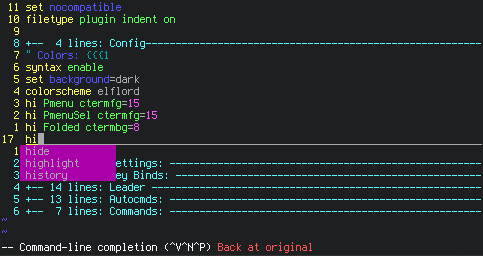Slim files: Vim
I have been ssh-ing into servers/vm’s recently and been editing things. Installing my dotfiles was a pain.
This is my attempt at making a set of viable slim config files, aimed specifically at what I might require when ssh-ing into a remote server.
First post was getting quite long so I’m going to split it up into parts. This article will be about vim.
Vim

I’m a heavy Vim user. Specifically console Vim. It’s at the hub of my development environment in the terminal. I have spent many an hour heavily modifying this program to do more or less exactly what I want it to do. Some of this time was spent configuring settings, creating keyboard mappings, researching and trying out third party plugins, and even writing a few of plugins of my own. My .vimrc is monolithically large.
However the use case here is much more temporal with a focus on a quick set up, minimal side effects, and easy tear down.
I won’t go line by line through my configuration as there is a lot of common/preferential things, but only highlight the things that are interesting.
Note: I looked long and hard at my plugin list, and decided that pretty much all of them I can live without. Specifically the biggest barrier was the cost of implementing or installing a plugin manager, and no single plugin added enough value to warrant paying it. If I was to utilise plugins (and I might later), my list would probably look something like this: nerdcommenter, endwise, surround, and targets.
let g:nicwest_remote = 1
let g:nicwest_os = 'linux'I’m thinking of adding some form of colour coding to both vim and tmux so can identify what machine I’m on regardless of content/hostname.
Similarly I’m not going to waste time working out what type of system I’m on, changing this when I need to work on a specific type of machine will be simple. 99% of the time this will be a machine running linux.
set background=dark
colorscheme elflord
hi Pmenu ctermfg=15
hi PmenuSel ctermfg=15
hi Folded ctermbg=8Elflord seems like a colour scheme that I don’t hate. I did however have to fix a couple of highlight groups that had poor legibility with my terminal colours.
set noundofile
set nobackup
set noswapfileThis one might be slightly questionable. Here is my thought process. If I ever found my self in a situation where I was able to do catastrophic and irreversible damage to a system simply by editing a single text file, then I think I would recognise this and make sure I had a manual and off server backup. Second I don’t want to litter files all over the system. I was thinking that there might even be a privacy/security side to this argument, but instead I’m going to err of the side of tidiness.
nnoremap <c-b> :buffers<CR>I have included a few personal key bindings in this config, but
this is the only one that might need some explanation. I have decided against
including any file manager plugins (such as nerdtree, unite
or ctrlp). I see Vim being used here as method of editing files
in situ which will mean that the majority of the time I see my self passing
the file name(s) as arguments when starting the program. If multiple files have
been opened after vim started, or even with wildcards (vim ./*), this is a
quick short cut to show how to bring up target files.
command! -bang Fuck if "<bang>" == "!" |
\ execute 'w !sudo tee > /dev/null %' |
\ echohl WarningMsg |
\ echo 'PEWPEW! SUDO!' |
\ echohl None |
\ endifFinally because I always forget it; here is the command to let you save as root
when you forget to start the program under sudo. :Fuck will do nothing,
:Fuck! will do the dirty.
Yup
I have been actively using this config for the last few days for preping some ansible set ups in vagrant. I’m actually surprised how much of a difference this makes. Just having the few sanity settings and a few familiar binds makes editing super comfortable.
One thing I have noticed that I’m missing the commenting functionality I got from nerdcommenter. It’s not really big enough to install the plugin, but I might take a look at implementing something light and similar later.